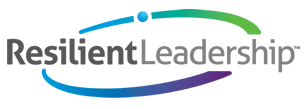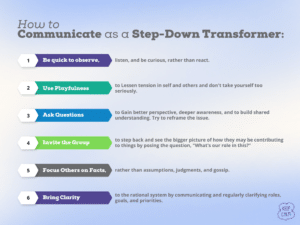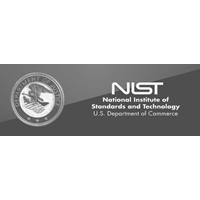
A Big Idea—A New Way of LEADING
Embody and Communicate a Less Anxious Presence
Let us explore the nature of a less anxious presence and how a leader can learn to embody this as a core leadership competency. Such a person can demonstrate and communicate an inner calm in a way that helps others to lower their own anxiety. But all it takes for a leader to act as a step-down transformer is to be less anxious than those around them. How to do that when everyone around us is acting as a step-up transformer?
Calming the Body
Let’s start with some basics: When we are anxious, our body immediately signals distress in subtle and not-so-subtle ways. The polygraph that measures key biometrics operates on the principle that most people are not consciously aware of, let alone able to mask, those subtle bodily changes when they are anxious about being caught in a lie. Similarly, specialists in reading body language have cataloged a list of key indicators that are below conscious awareness, yet to the trained eye, signal a range of emotions and moods. The good news is that if we pay attention, we can learn to spot many bodily signs of heightened anxiety in ourselves. And once we realize that our body is carrying that anxiety, we can work on calming ourselves by deliberately relaxing our body.
What are some of the frequent bodily indicators of anxiety? For some people, raised shoulders and a slight curving in of the body to protect vital organs or an effort to shrink in size as if to avoid being a target can be telltale signs of anxiety. For many, shallow breathing and tension in the jaw, back, chest, neck, or stomach are common signals of inner tension. These are all common ways we display anxiety. If we pay attention to what our body is telling us, we can lower anxiety by taking countermeasures that help to calm our anxious minds and feelings.
There are many simple physical moves that can relax our bodies and help us manage and roll back our anxiety. One practice we suggest because it can be done virtually any time or anywhere is what we call six-second centering. We have taught six-second centering to hundreds of leaders, and most of them find it an invaluable way to calm their nervous system so that they can think more clearly and creatively about the challenges and threats causing them to feel anxious in the first place.
Many other physical relaxation practices are worth exploring and can be done before, during, or after heightened anxiety. Preventative steps to help us remain calm so that our chronic anxiety never reaches too high a level may be even more helpful.
Here is a sampling of the many preventive practices that leaders we have worked with have used to maintain a less anxious presence:
- Develop a repertoire of activities that help you to center yourself (e.g., exercise, yoga, meditation/mindfulness, etc.)
- Take care of the basics that are foundational to emotional bandwidth, like getting enough exercise and sleep and eating properly
- Focus on/get in touch with your strengths and who you are at your best
- Reconnect with the noble purpose of your life to gain perspective. Keep a reflective journal
- Find support systems that help you to relax and become more thoughtful (e.g., coaching, therapy, peer groups, mentors)
- Talk with a trusted colleague about what is raising your level of anxiety
A leader with a less anxious presence embodies and communicates an inner calm that helps others lower their anxiety. Doing so paves the way for clear thinking to prevail.
Communicating a Calm Presence
Sometimes a simple change in how we communicate is all it takes to begin the process of calming an anxious system. Our experience with a senior team of a high-tech company in the midst of rolling out massive changes to key processes and a sweeping reorganization is an excellent example of this. Not surprisingly, the organization was experiencing a rise in both acute and chronic anxiety, and many employees (including some of the senior team members) were displaying the reactive behaviors we mentioned earlier. Knowing that it was up to them as leaders to calm the system, they asked us to share some strategies to communicate more effectively as step-down transformers and bring some calm to a highly reactive system. We shared with the team the behaviors and communication strategies you see below. We asked every leader to pick one to commit to practicing over the next month as the process and reorganization changes were rolled out.
When we met with the team a month later, one senior leader spoke about how he had decided to become a “curious questioner” rather than a “know-it-all leader.” Instead of succumbing to the pressure he felt to supply the answer to every problem or question his employees brought to him, he practiced asking questions from a place of genuine curiosity to draw out the facts and their own best thinking. In doing so, he reported a significant drop in their anxiety and reactivity levels and his own.
You Can’t Be Curious and Anxious at The Same Time
Asking questions from a place of curiosity is a powerful way to lower anxiety and bring greater thoughtfulness to a situation. Neuroscience research tells us that it is next to impossible to be curious and anxious simultaneously! Questions alone aren’t enough. We’ve all been at the receiving end of the interrogation, which is all about asking questions but not from an open, curious stance. On the other hand, inquiry means “to inquire from a place of openness” and requires a willingness on our part to be influenced by what we hear. Leaders who act as step-down transformers understand this distinction and work to practice skillful inquiry rather than interrogation. The example above underscores how adopting even one of these step-down transformer practices can make a big difference. From a systems perspective, this makes sense, as what affects one affects all.
(Excerpts taken from Resilient Leadership 2.0 / Bob Duggan & Bridgette Theurer © 2017)
For more information on A Less Anxious Presence and Step-Down Transformers, Contact us through this website, email Jimm@resilientleadershipdevelopment.com, or call us at 301-922-4221.













